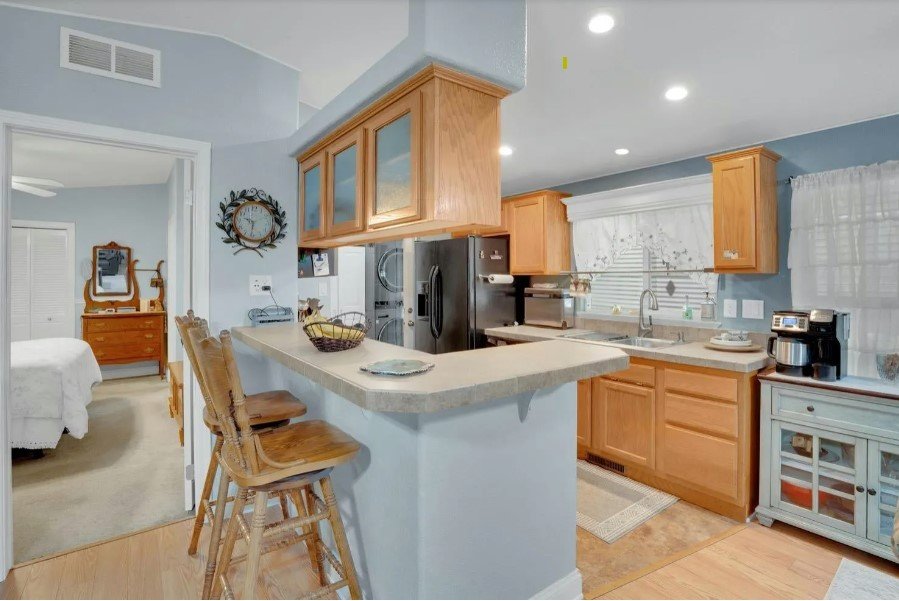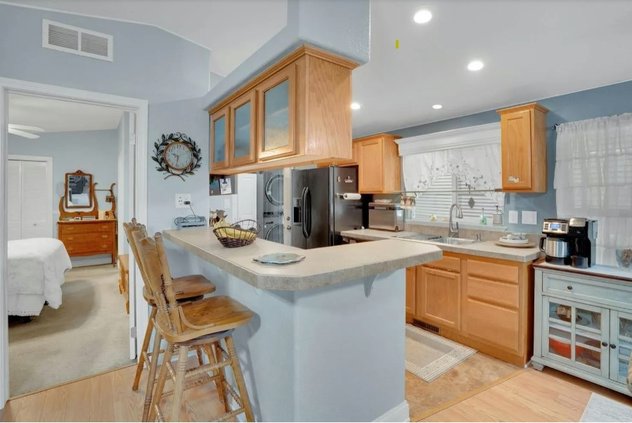Want to see what at-market affordable housing looks like in Manteca?
It certainly isn’t Pulte Homes and other developers in the southwestern portion of the city that are neck-in-neck in the race to become the first builder of $1 million tract homes in Manteca.
Nor is it Raymus Homes, the second generation local builder that traditionally has delivered the lowest priced new tract home in Manteca.
You can find the biggest cluster in a short stretch of Yosemite Avenue just east of Highway 99 with the “neighborhood” names of El Rancho and Almond Blossom.
Another at-market affordable Manteca neighborhood is snuggled against the Manteca High stadium along Moffat Boulevard.
Hold on, you might say, those are mobile home parks.
Got a problem with that?
True, they don’t look like “Beaver” Cleaver’s home or his Mayfield neighborhood.
That said, they are not subsidized housing.
As such, it means those who occupy the housing units are paying for it out of their own pocket and are not living in government subsidized housing.
Keep in mind these are mobile home parks that were built 55 years ago.
Take a look at stick-built tract home neighborhoods dating back to 1970 and before in Manteca — or any other California city for that matter.
Based on modern standards and sensibilities they look aged.
It doesn’t mean they are blighted et al.
They, for the most part, just look older.
It will be the same for the homes being built today when the year 2079 rolls around.
And today, they are not mobile home parks as much as they are manufactured home parks.
They look more like traditional homes because they are traditional homes complete with architectural gingerbread on street-facing facades.
The big difference is they are built for the most part in factories as modular units. That, in turn, reduces building costs.
That is just part of the cost savings story.
A standard stick-built tract home neighborhood has 5 homes per acre.
Manufactured home parks have 10 homes per acre.
That’s double the density on the same amount of land.
If that many one-story housing units on an acre bother you, then take a look at the future of California standalone housing, including in the Central Valley.
Examples are North Main Commons on North Main Street across from the casino, Yosemite Greens on Airport Way backing up to the golf course, and neighborhoods such as Walnut Place at Walnut and Alameda or the Golf Villas along Union Road.
You practically can lean out the window, ask a neighbor if they have Grey Poupon, and they will be able to pass it to you from their window.
Side yards are shrinking out of necessity as are ornamental front yards.
It is helping keep costs down.
The manufactured home parks go one step further.
Not only are front yards compacted further but backyards are shrunk significantly.
To be honest, you can look at a lot of new homes built in the last year to 20 years ago, and a lot of them don’t have much more than grass, if that, over the majority of their backyards.
It is the result of cost and/or changing lifestyles.
Modern manufactured home parks — the successor to basic mobile home parks — have more open space, useable common areas — that serve as neighborhood parks.
As manufactured home parks age, there is less infrastructure replacement needs and costs.
It’s because “neighborhood” streets are significantly narrower and there are more homes served via linear feet of sewer, water, and storm drain lines.
There are concerns that those who buy homes in manufactured home parks won’t own the land and therefore will be subject to a corporation’s whims at raising lot “rent” or the inevitable higher costs that come when parks are sold.
There are ways around that.
Manufactured home parks can be developed and established with the top tier homeowners association model that Del Webb pioneered and used for years for the communities they built.
It basically is a system where the HOA collects fees not just for maintenance but for a sinking fund to underwrite the ultimate need to repave streets and replace sewer and water lines that fail over time.
There could conceivably be a community facilities district model created that would add government oversight to eliminate the downside that some HOAs that are more holistic have which is making sue operating and maintenance costs and issues are handled in a proper manner.
The City of Manteca’s recently adopted general plan does not include zoning for manufactured home parks that have played a major role in more than few Southern California cities to provide more affordable at-market housing opportunities.
It was not an oversight as much as a bias displayed by city planners and the consultant during the early part of the seven-year gestation period for the general plan update.
It had been suggested at the citizens level outreach that manufactured home parks be encouraged and land set aside for that purpose with the proper zoning, preferably to the northeast of the existing city limits.
It was shot down based on biased connotations so-called “professional planners” projected onto manufactured home parks of prejudice against mobile home parks per se fed by caricatures created by Hollywood and, for want of a better term, “cultural snobbery.”
Take a look at Almond Blossom and El Rancho.
They are clean and kept.
And they are the most affordable free-standing housing in Manteca.
New manufactured home parks such as San Joaquin County is in the process of working to encourage with new zoning rules have modern design and development standards.
One would expect the same thing should Manteca’s leaders stop talking a big game and actually put in place rules and zoning that allow the market to meet the housing needs of people who work in Manteca earning an income that is “too high” to qualify for subsidized housing so they can afford to live here.
Perhaps the city might want to amend the Manteca general plan to make it possible for more inclusive housing options.
Expanding the inventory of favorable at-market housing is key to reduce the real good chance that ultimately people without Bay Area paychecks won’t be able to afford to buy or rent in Manteca.
This column is the opinion of editor, Dennis Wyatt, and does not necessarily represent the opinions of The Bulletin or 209 Multimedia. He can be reached at dwyatt@mantecabulletin.com





